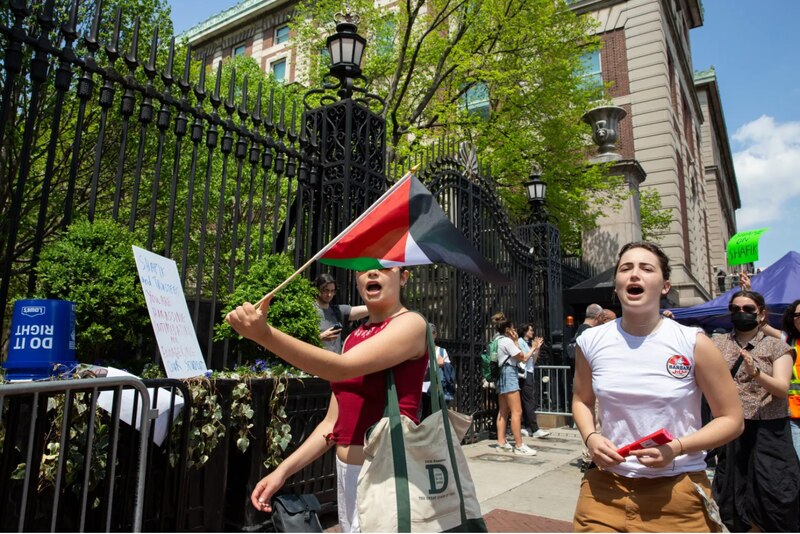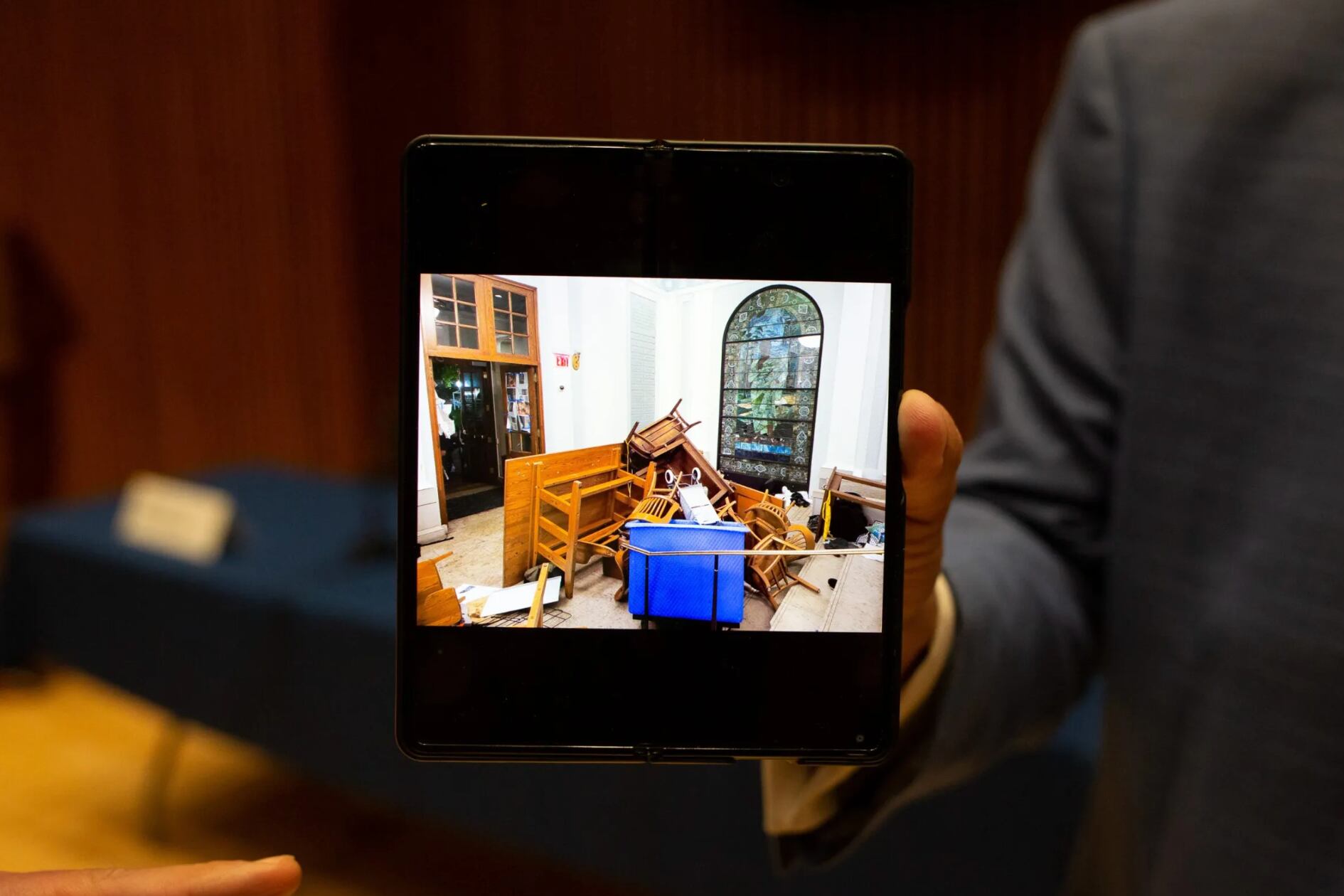This story was originally published on May 1 by THE CITY. Sign up here to get the latest stories from THE CITY delivered to you each morning.
New York City Mayor Eric Adams and top police officials continued to blame “outside agitators” for the campus protests against the war in Gaza that have swept the nation.
At a press briefing Wednesday morning, officials confirmed they’d arrested nearly 300 people in back-to-back crackdowns on protests at Columbia University and the City College of New York overnight.
Police officials said they are also keeping tabs on the remaining protest encampments around the city. As of Wednesday, college pro-Palestinian demonstrators calling for divestment from Israel were still camped out at NYU and the Fashion Institute of Technology, while demonstrators at Fordham University’s Lincoln Center Campus began their own encampment Wednesday morning.
At the press briefing, Adams reiterated a claim he and his top officials have made on national television appearances over the past several days: that the demonstrations have been fomented by “outside agitators.”
“There is a movement to radicalize young people and I’m not going to wait until it’s done and all of a sudden acknowledge the existence of it,” Adams said. “I’m not going to allow that to happen as mayor of the city of New York.”
Pressed multiple times during the press briefing to identify those “outside agitators,” officials declined to provide specifics.
“We’re in the process of sorting through all of the data that were covered last night,” said Rebecca Weiner, the department’s deputy commissioner of iIntelligence and counterterrorism who’s also listed as an adjunct professor at Columbia’s School of International and Public Affairs.
Weiner said it was too early to say how many of the 300 people arrested across two campuses Tuesday evening were directly affiliated with either institution. “So sifting through the names of everybody and whether they are affiliated with school or not, that takes time and we want to make sure that we’re giving you accurate information.”
Later, Fabien Levy, a deputy mayor for Adams, told reporters that Lisa Fithian, a prominent longtime activist not affiliated with Columbia, had been there to back up City Hall’s claim of outside agitators.
NYPD officials also brought in a chain and lock to the press conference, as well as to television appearances throughout the morning, as an example of something students would not have brought to school.
A reporter for the New York Times pointed out on Twitter that Columbia’s own public safety department was advertising the same locks on its website.
‘An incredible scene’
More details emerged from the crackdown that occurred on the City College of New York campus where NYPD used pepper spray and body-slammed some people during arrests. All told police arrested 173 people, officials confirmed Wednesday morning.
In a statement released by the released on X from the CUNY Gaza Solidarity Encampment, students described an array of injuries they’d suffered during the crackdown: an undergraduate student broke their ankle, two more suffered broken teeth, others were pepper sprayed at close range.
“We will not be intimidated by the brutal and spineless tactics,” the statement read. A spokesperson for the NYPD declined to comment on the students’ statement.

Columbia student organizers wrote that several students were taken to the hospital, while others were kicked in the face during the arrests.
A FDNY spokesperson confirmed three people with minor injuries were taken to the hospital from a staging area for the demonstrations at Riverside Drive and West 139th Street at around 7 p.m.
One Columbia student organizer wrote on X that the NYPD had removed some students’ hijabs while they were in detention, something the NYPD has had to pay millions for in past settlements. The student organizer who tweeted the account couldn’t be reached for additional comment right away, and the NYPD didn’t immediately return a request for comment.
At Wednesday’s press briefing Adams praised the NYPD’s mass arrests.
“Through the NYPD’s precision policing. We showed that the operation was organized, calm, and there were no injuries or violent clashes,” he said. “National independent journalists acknowledged what the police department did yesterday and they were on the ground to see, and I want to be clear that we will continue to continue to use this level of professionalism.”
But at both raids, however, NYPD officials, as well as Columbia campus security, restricted access to reporters, erecting barriers around both campuses and, making it nearly impossible for those not already on site to observe arrests.
At Columbia, campus, student journalists and a CITY reporter were forced into adjoining buildings and blocked in for several hours, unable to observe officers entering Hamilton Hall, or the arrests of students who’d linked arms to try and block the entryway to the hall. Video of the start of the arrests recorded by FreedomNews.TV showed one protester rolling violently down the stairs.
At City College, where the reporters were also cordoned off, top NYPD officials posted their own video of themselves raising an American flag, proclaiming it “an incredible scene and proud moment.”
‘Left us no choice’
As campus protests against the war in Gaza that’s killed more than 34,000 Palestinians swept the nation, pressure has mounted on universities to clamp down on them. Some Jewish students have said the ongoing demonstrations have made them feel unsafe on campus and Columbia and City College both largely closed their campuses and moved to online classes.
Though Columbia President Minouche Shafik had expressed reluctance to deploy the NYPD on students for a second time, the administration said Tuesday, the occupation of Hamilton Hall, which occurred early that morning, forced the university’s hand.
“The events on campus last night have left us no choice,” a Columbia administrator wrote in a letter to NYPD officials requesting their help clearing the building, which was later shared on X by police officials. The letter also requested NYPD presence on campus through May 17 to assure no additional encampments sprout up.
In a similar letter also shared by the NYPD, officials from City College also requested backup from police saying “protesters have refused to comply with our directives to remove unauthorized structures and/or flags, banners, posters and the like.”
Noah Grady, a CUNY spokesperson, said they called the NYPD for backup after demonstrators attempted to break into one campus building, and successfully broke into an administrative building, vandalizing it and breaking glass.
“Students have a right to demonstrate peacefully and exercise their First Amendment rights. Tuesday night’s actions were taken in response to specific and repeated acts of violence and vandalism, not in response to peaceful protest,” he said. “CUNY will continue working to keep our community free from violence, intimidation and harassment.”
Columbia University has a long history of student-lead occupations. After a violent police crackdown on Vietnam War protests, “fallout dogged Columbia for years,” according to the University’s own account of the era decades later.
In a statement Wednesday from Shafik, she acknowledged “it is going to take a long time to heal.”
“I hope we can use the weeks ahead to restore calm, allow students to complete their academic work, and honor their achievements at Commencement.”






